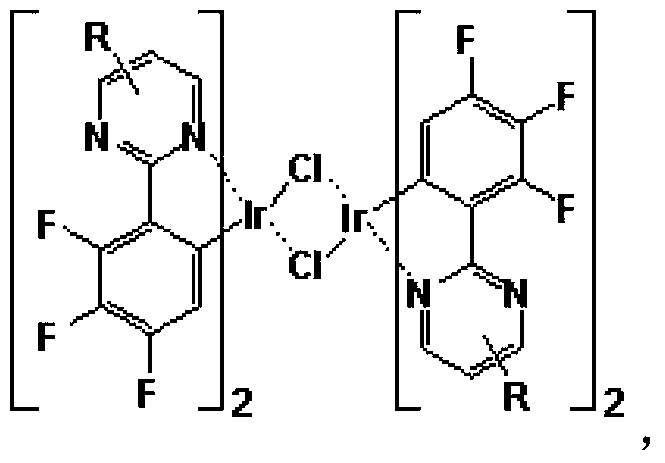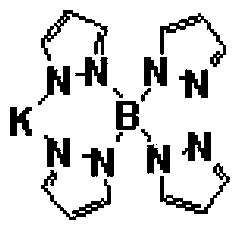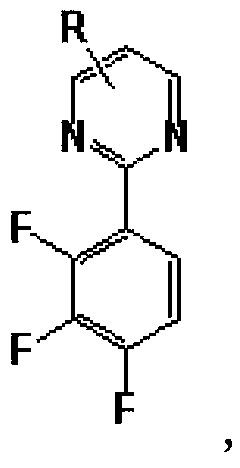Organic electro-phosphorescent material and preparation method thereof, and organic electroluminescent device
A phosphorescent material, electrophosphorescence technology, applied in luminescent materials, electro-solid devices, organic chemistry, etc., to reduce the probability of non-radiative transitions, improve luminous efficiency, and increase solubility
- Summary
- Abstract
- Description
- Claims
- Application Information
AI Technical Summary
Problems solved by technology
Method used
Image
Examples
preparation example Construction
[0038] The present invention also relates to a method for preparing the above-mentioned organic electro-phosphorescent material. The method sequentially includes the following steps:
[0039] 1. Make compound E and compound F through Suzuki coupling reaction to synthesize compound C; wherein, compound F is 2,3,4-trifluorophenylboronic acid, and the structural formulas of compound E and compound C are as follows:
[0040] Compound E is Compound C is
[0041] 2. The compound C obtained in step 1 is reacted with compound D to form a chlorine bridged dimer, namely compound A. Among them, compound D is iridium trichloride trihydrate IrCl 3 ·3H 2 O. The structural formula of compound A is as follows:
[0042]
[0043] 3. The compound A prepared in step 2 is used as the main structure of the cyclometal ligand, and potassium tetrakis (1-pyrazole) boride (compound B) is used as an auxiliary ligand source, and compound A and compound B are reacted to obtain iridium Metal complexes, namely o...
Embodiment 1
[0051] The organic electrophosphorescent material disclosed in this embodiment is the complex bis(2-(4′,5′,6′-trifluorophenyl)pyrimidine-N,C 2 ′) (Tetra(1-pyrazole) boron) iridium, its structural formula is as follows:
[0052]
[0053] It is prepared by the following steps:
[0054] (1) Synthesis of 2-(2′,3′,4′-trifluorophenyl)pyrimidine
[0055] The synthetic reaction formula is as follows:
[0056]
[0057] The specific steps are: under a nitrogen atmosphere, 1.59g (10mmol) 2-bromopyrimidine, 2.11g (12mmol) 2,3,4-trifluorophenylboronic acid and 0.58g (0.5mmol) tetrakis(triphenylphosphorus) Palladium was dissolved in 40ml of toluene, and then 20ml of an aqueous solution containing 2.76g (20mmol) of potassium carbonate was added dropwise to the reaction system, heated, and stirred at 100°C for 6h. After the reaction solution was cooled to room temperature, use dichloromethane Extract, separate, wash with water to neutrality, then dry with anhydrous magnesium sulfate, then filter, th...
Embodiment 2
[0073] The organic electrophosphorescent material disclosed in this embodiment is a complex complex bis(2-(4′,5′,6′-trifluorophenyl)-5-methylpyrimidine-N,C 2 ′) (Tetra(1-pyrazole) boron) iridium, its structural formula is as follows:
[0074]
[0075] It is prepared by the following steps:
[0076] (1) Synthesis of 2-(2′,3′,4′-trifluorophenyl)-5-methylpyrimidine
[0077] The synthetic reaction formula is as follows:
[0078]
[0079] The specific steps are: under a nitrogen atmosphere, 1.73g (10mmol) 2-bromo-5-methylpyrimidine, 1.76g (10mmol) 2,3,4-trifluorophenylboronic acid and 0.28g (0.4mmol) dichlorobis (Triphenylphosphorus) palladium was dissolved in 50 ml of DMF, and then 25 ml of an aqueous solution containing 3.18 g (30 mmol) of sodium carbonate was added dropwise to the reaction system. Heat to 90°C and stir for 8 hours. After the reaction solution is cooled to room temperature, extract with dichloromethane, separate the layers, wash with water to neutrality, dry with anhydr...
PUM
| Property | Measurement | Unit |
|---|---|---|
| thickness | aaaaa | aaaaa |
| thickness | aaaaa | aaaaa |
| thickness | aaaaa | aaaaa |
Abstract
Description
Claims
Application Information
 Login to View More
Login to View More - R&D
- Intellectual Property
- Life Sciences
- Materials
- Tech Scout
- Unparalleled Data Quality
- Higher Quality Content
- 60% Fewer Hallucinations
Browse by: Latest US Patents, China's latest patents, Technical Efficacy Thesaurus, Application Domain, Technology Topic, Popular Technical Reports.
© 2025 PatSnap. All rights reserved.Legal|Privacy policy|Modern Slavery Act Transparency Statement|Sitemap|About US| Contact US: help@patsnap.com



